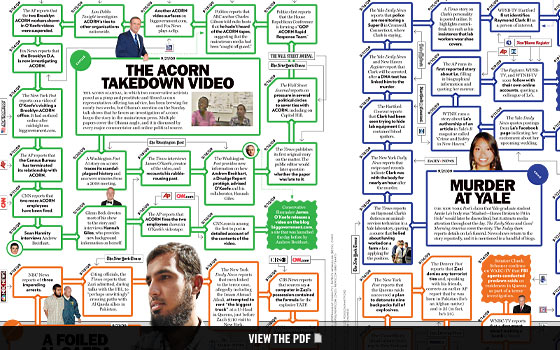
Over the past year, there has been much talk about the future of traditional news organizations. While the Internet has made disseminating, discussing, and riffing on news much less costly, the reporting of news—the bringing of new facts to bear on a story—remains very expensive, and it’s not clear that a financial model still exists to support it. Faced with evaporating advertising revenues, the Tribune Company (owner of the Chicago Tribune and the Los Angeles Times) filed for bankruptcy in late 2008, followed by the Star Tribune of Minneapolis, the Philadelphia Inquirer’s parent, and the Journal Register Company, which at the time owned twenty daily papers and 159 non-daily papers in the northeast. In January, the New York Times negotiated a $250 million loan—at unfavorable terms—from the Mexican billionaire Carlos Slim Helú in order to shore up its cash flow.
The question being hashed out on journalism blogs and over power lunches at Michael’s is how much this matters. Bill Keller, the Times’ executive editor, has spent considerable energy justifying his employer’s existence to a contrarian chorus of “new media” bloggers—and even some longtime print journalists. In The Atlantic in January, Michael Hirschorn concluded his article on the possible death of the Times by saying it would be “a severe blow to American journalism” but perhaps not a disaster. The writer Jeff Jarvis has argued that newspapers could be replaced, at no substantial cost to society, by “an ecosystem made up of many players” including hyperlocal blogs and nonprofit newsrooms. This summer, a couple of news junkies deprived themselves of newspapers for three days and blogged about the experience on Slate. They survived.
“Society doesn’t need newspapers,” wrote Clay Shirky in a widely read blog post this March. “What we need is journalism.” Shirky was trying to shift the conversation from the fate of particular institutions to the project of original reporting. But who does in fact break news? Where do previously unknown twists to a story come from? Rather than exploring the question rhetorically, we decided to conduct a little experiment. We took a random Monday— September 21, 2009—and gathered all the news that was reported that day from 84 news sources across the spectrum, including sixteen major papers; thirteen magazines; many prominent network, cable, and radio news shows; and eighteen news-focused websites. Then we chose seven stories and set out to determine who was responsible for the individual pieces of original reporting that advanced each one.

Much of that day’s news cycle was spent digesting events that happened in plain sight. Obama had just been on a record five Sunday talk shows. The Emmys had aired the night before. The Dallas Cowboys had debuted their new stadium. Somewhere (everywhere?) a press conference was taking place about something. And, of course, much of the commentary had to do with new ideas or opinions rather than new facts; Obama’s criticism of cable television’s “rude and outrageous” rhetoric on the talk shows, for instance, prompted hundreds of responses that day on whether impertinence was on the rise. But the biggest news of the day was, it turns out, driven by a classic big-paper scoop: Bob Woodward had gotten his hands on General Stanley McChrystal’s confidential assessment of possible “mission failure” in Afghanistan and had written about it in the Washington Post. Politics junkies, meanwhile, were focused on a Times scoop from the weekend—that the White House was trying to push David Paterson out of the New York governor’s race.
The day was filled with slight revelations and rolling chatter in ongoing stories—the cause of Michael Jackson’s death, the disputed gender of South African runner Caster Semenya—and many of the stories we traced back relied on a wide variety of newsgathering sources. The ACORN videotape scandal was not only driven by online news and radio troublemakers, it was created by one, as the filmmaker James O’Keefe teamed up with Andrew Breitbart, a Drudge Report protégé who launched a site where the film would be hosted. In the case of the murder of Yale student Annie Le, details of the crime and its investigation were picked up by national media after local sources (including the Yale Daily News) uncovered them. The question of whether John Edwards fathered a child with Rielle Hunter had been pursued relentlessly by the National Enquirer, hardly the most Establishment title that comes to mind, but it was the exhaustive article the Times ran the day before that legitimized the story and drove the coverage on September 21. Perhaps the biggest surprise of the day: It took fourteen years—and the upcoming publication of a book on the Clinton presidency—to report the fact that Boris Yeltsin had roamed Pennsylvania Avenue in his underwear looking for pizza.